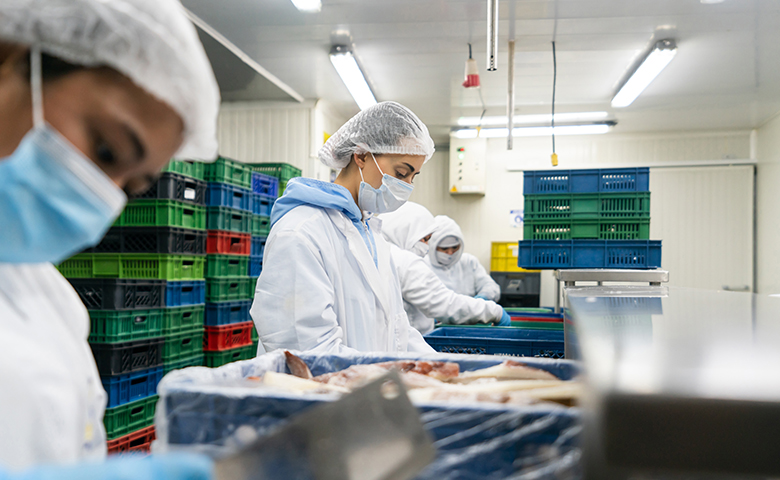Chances are, if you’ve enjoyed fish sticks or frozen filets, or even ordered fish at a restaurant, you can thank High Liner Foods’ workers for your dinner. The company is famous for its value-added frozen seafood. But it also deserves recognition for its impressive safety culture, which is driven by a human factors approach that manages to keep people in perspective even when the fish hits the fan.
When a food manufacturing system is disrupted, it’s easy to be blinded by the numbers. There’s a cost to production downtime, and according to Processing Magazine, it’s about $30,000 per hour. That’s not necessarily accounting for lost product either. When a production line suddenly halts, and those losses start adding up with every second that passes, people begin to panic.
That’s certainly what High Liner Foods found when it looked into a spike in safety incidents at its Lunenburg, Nova Scotia location. The facility experienced five relatively severe events at a frequency it had never seen before, and they all stemmed from the panic caused by what the company’s EHS Director, Erika Pouliot, calls “upset systems.”
Panic! at the fish factory
In a SafeStart Lunch & Learn presentation, Pouliot defined an upset system as when “…something on the line is going well and then all of a sudden, whoops—it’s not going well. Something stops.”
When that happens, workers start to worry about numbers more than safety. Wasted products, money lost to downtime, missed quotas—these are all high-stakes distractions that introduce negative human factors into a scenario. “Everybody turns into a tizzy and everybody’s rushing around and trying to get it done and it’s just kind of chaos,” said Pouliot. “And that’s where incidents were actually happening.”
It’s important to contextualize what an upset system looks like for High Liner Foods. Its workers are part of a manufacturing process that takes fish from the sea and brings them to your plate ready to eat. When that system between the fishing line and someone’s dinner is upset, fish start flying.
“People start panicking,” said Pouliot. “Fish is expensive. And so they are taught right away: the amount of fish on the floor equals so many dollars, and then the next thing you know…”
The incidents recorded at the Lunenburg facility grew from this fish-first mindset. That’s not to say this was negligence or the result of a toxic workplace—it wasn’t. The company has a remarkable culture across its entire operation—it cares about its employees, and that care helped find a solution to the rise in incidents. By opening a dialogue between the leadership team and the workers, High Liner Foods was able to better understand the messaging coming down from the top.
The cost of preventable injuries
Pouliot said she challenged her leadership team to seriously consider how much time they spent talking about safety compared to production numbers. Even when safety is being promoted as important, it can be overshadowed when more time is spent on the metrics of lost product. This can put workers in a tough position, weighing their safety against the consequences of spilled fish. She challenged the Lunenburg site specifically to review their communications: what they were saying, and what employees were hearing. When a manufacturing manager spoke to some frontline workers, he received a common response: “Safety is important, but you do talk about the numbers more.”
“And so they’re starting to hear that the numbers are more important than people, and the focus is more on the numbers and not on their safety,” said Pouliot.
Ironically, there is also a cost to workplace incidents that result in injury. The number varies depending on the situation, but on average the direct cost of a workplace injury is $41,000, which increases exponentially when you take into account a variety of indirect costs. Then consider that an injury during an upset system event further complicates the crisis at hand, likely increasing the downtime and amplifying the financial fallout. Preventable injuries and product waste are not two sides of a trade-off—a company won’t save money during a system upset by sacrificing worker health and safety. Both elements conspire to threaten a food manufacturer’s bottom line.
Fighting chaos with leadership
The Lunenburg site began to focus heavily on making sure its management team and supervisors weren’t just paying lip service to safety, explained Pouliot. “They had to walk the talk,” she said. “They had to basically help with that chaos and show them through example: ‘Okay, if this is going on, this is how we’re going to handle it, in a much better-paced mode, logically thinking through and [with] a little bit more organization.’”
Essentially, the workers were shown by their leadership that while an upset system must be addressed, it does not call for rushing. Moving too quickly in a panic was actually making things worse. But if a worker frequently hears reprimanding language about upset system losses, they will be naturally inclined to move too fast to achieve their goal safely. By having supervisors and managers demonstrate that safety is more important than rushing to get a system back up and running, the workers had permission to keep their eyes and minds on the task of correcting what went wrong in the first place.
And the human factors approach succeeded. By ensuring that workers’ mindsets and priorities were considered in upset systems, High Liner Food’s Lunenburg facility was able to eliminate preventable injuries that arose due to the chaos that surged forth from upset systems, going for over two years without a recordable incident afterward. It’s a perfect example of how ensuring people are thinking about practical safety advice instead of abstract numbers can have a positive, cascading effect on a worksite, even when things start to get fishy.

